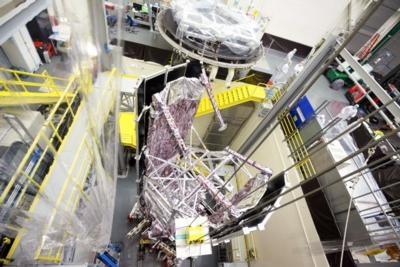Tue, Jun 04, 2019
Spacecraft Element Successfully Endures Extreme Temperatures In Thermal Vacuum
NASA’s James Webb Space Telescope Spacecraft Element (SCE) successfully completed its last environmental test, thermal vacuum testing, at Northrop Grumman Corporation in Redondo Beach, CA.

Thermal vacuum testing exposes Webb’s SCE to the extreme hot and cold temperatures it will experience in space. To test these extreme temperature ranges, the chamber uses liquid nitrogen shrouds and heater panels to expose the SCE to cold temperatures as low as -300 degrees Fahrenheit and hot temperatures as high as 220 degrees Fahrenheit. Real-time data collection via flight sensors on the SCE allow engineers to monitor Webb’s electrical/unit functionality and ensures the structure will withstand the rigors of its cold journey to and operation at the second Lagrange point.
“The world’s largest space telescope has to perform in extreme temperatures,” said Scott Willoughby, vice president and program manager, James Webb Space Telescope, Northrop Grumman. “Successful completion of thermal vacuum testing ensures the SCE can endure the volatile conditions it will face and further validates Webb’s readiness for launch.”
Webb’s SCE completed its two prior environmental tests (acoustic and sine vibration). After thermal vacuum testing, the SCE will return to Northrop Grumman’s clean room to begin post-environmental testing, including deployments. Later this year, the Webb telescope will become a fully integrated observatory for the first time through integration of the SCE to the Optical Telescope Element/Integrated Science Instrument Module.
The James Webb Space Telescope will be the world’s premier space science observatory of the next decade. Webb will solve mysteries in our solar system, look to distant worlds around other stars, and probe the mysterious structures and the origins of our universe. Webb is an international program led by NASA with its partners, the European Space Agency and the Canadian Space Agency.
(Image provided with Northrop Grumman news release)
More News
From 2023 (YouTube Version): Legacy of a Titan Robert (Bob) Anderson Hoover was a fighter pilot, test pilot, flight instructor, and air show superstar. More so, Bob Hoover was an i>[...]
Get The Latest in Aviation News NOW on Instagram Are you on Instagram yet? It's been around for a few years, quietly picking up traction mostly thanks to everybody's new obsession >[...]
Aero Linx: B-52H Stratofortress The B-52H Stratofortress is a long-range, heavy bomber that can perform a variety of missions. The bomber is capable of flying at high subsonic spee>[...]
Altimeter Setting The barometric pressure reading used to adjust a pressure altimeter for variations in existing atmospheric pressure or to the standard altimeter setting (29.92).>[...]
"Knowing that we play an active part in bettering people's lives is extremely rewarding. My team and I are very thankful for the opportunity to be here and to help in any way we ca>[...]
 Classic Aero-TV: Remembering Bob Hoover
Classic Aero-TV: Remembering Bob Hoover ANN FAQ: Follow Us On Instagram!
ANN FAQ: Follow Us On Instagram! ANN's Daily Aero-Linx (05.15.24)
ANN's Daily Aero-Linx (05.15.24) ANN's Daily Aero-Term (05.15.24):Altimeter Setting
ANN's Daily Aero-Term (05.15.24):Altimeter Setting Aero-News: Quote of the Day (05.16.24)
Aero-News: Quote of the Day (05.16.24)



